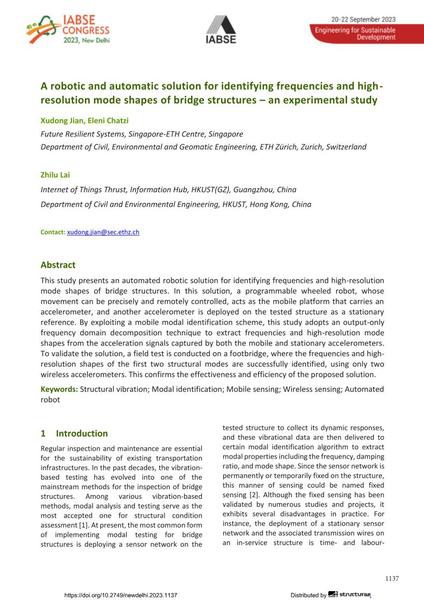A robotic and automatic solution for identifying frequencies and high- resolution mode shapes of bridge structures – an experimental study

|
|
|||||||||||
Bibliographic Details
| Author(s): |
Xudong Jian
(Future Resilient Systems, Singapore-ETH Centre, Singapore)
Eleni Chatzi (Future Resilient Systems, Singapore-ETH Centre, Singapore) Zhilu Lai (Internet of Things Thrust, Information Hub, HKUST{GZ}, Guangzhou, China Department of Civil and Environmental Engineering, HKUST, Hong Kong, China) |
||||
|---|---|---|---|---|---|
| Medium: | conference paper | ||||
| Language(s): | English | ||||
| Conference: | IABSE Congress: Engineering for Sustainable Development, New Delhi, India, 20-22 September 2023 | ||||
| Published in: | IABSE Congress New Delhi 2023 | ||||
|
|||||
| Page(s): | 1137-1143 | ||||
| Total no. of pages: | 7 | ||||
| DOI: | 10.2749/newdelhi.2023.1137 | ||||
| Abstract: |
This study presents an automated robotic solution for identifying frequencies and high-resolution mode shapes of bridge structures. In this solution, a programmable wheeled robot, whose movement can be precisely and remotely controlled, acts as the mobile platform that carries an accelerometer, and another accelerometer is deployed on the tested structure as a stationary reference. By exploiting a mobile modal identification scheme, this study adopts an output-only frequency domain decomposition technique to extract frequencies and high-resolution mode shapes from the acceleration signals captured by both the mobile and stationary accelerometers. To validate the solution, a field test is conducted on a footbridge, where the frequencies and high- resolution shapes of the first two structural modes are successfully identified, using only two wireless accelerometers. This confirms the effectiveness and efficiency of the proposed solution. |
||||
| Keywords: |
modal identification Structural vibration Mobile sensing Wireless sensing Automated robot
|
||||
